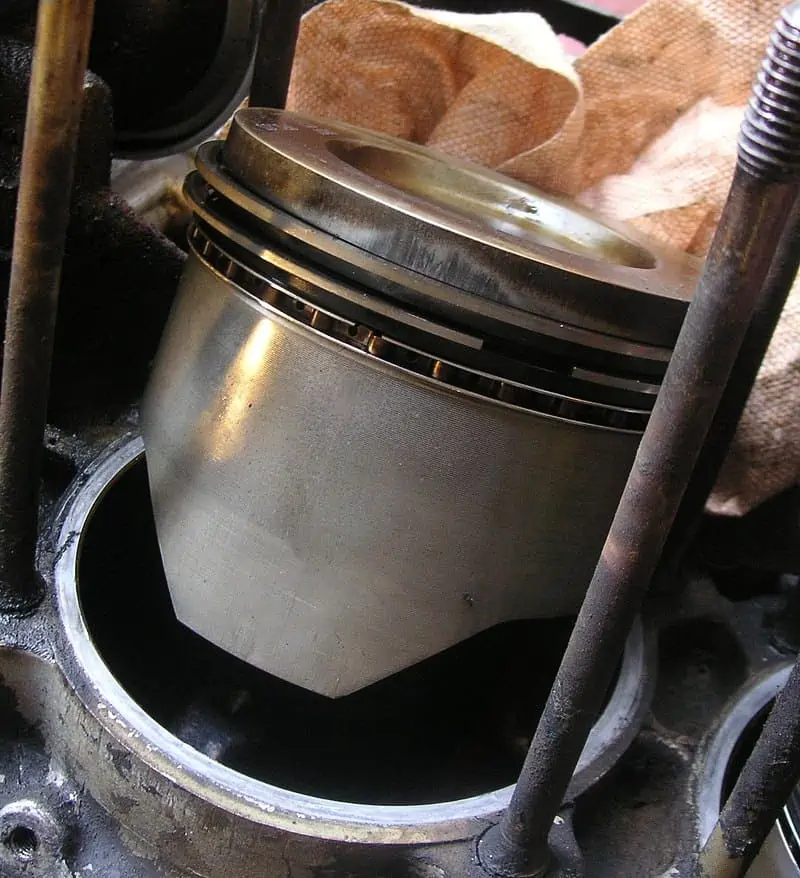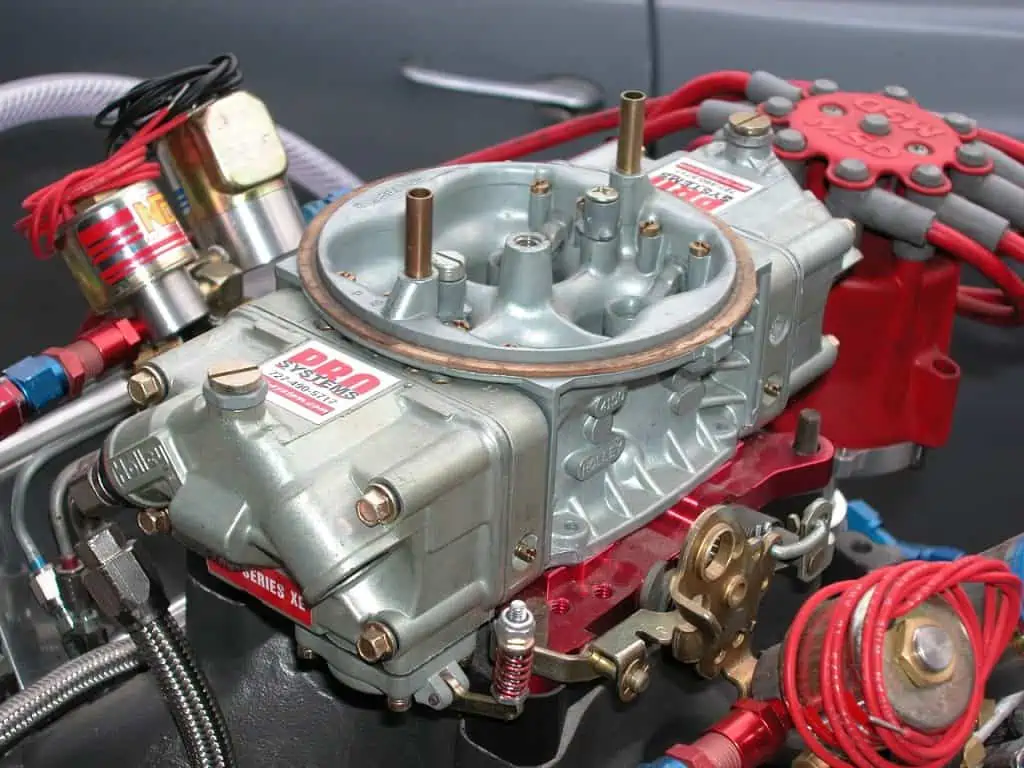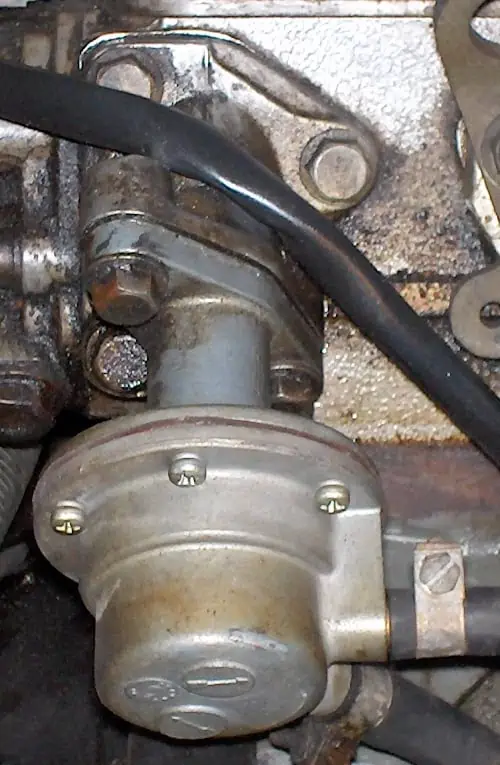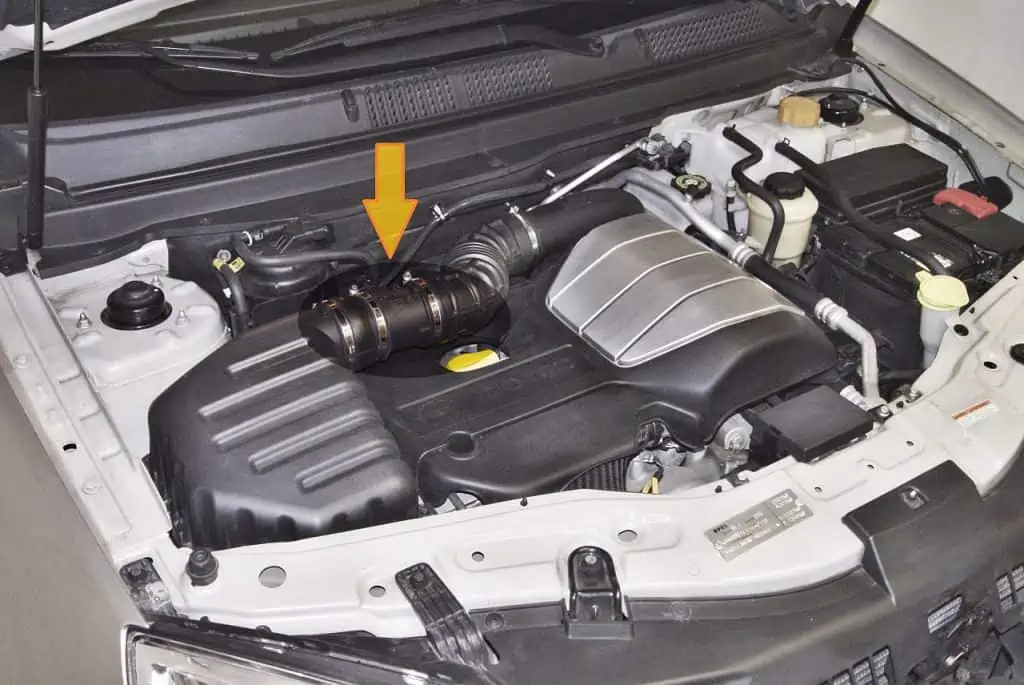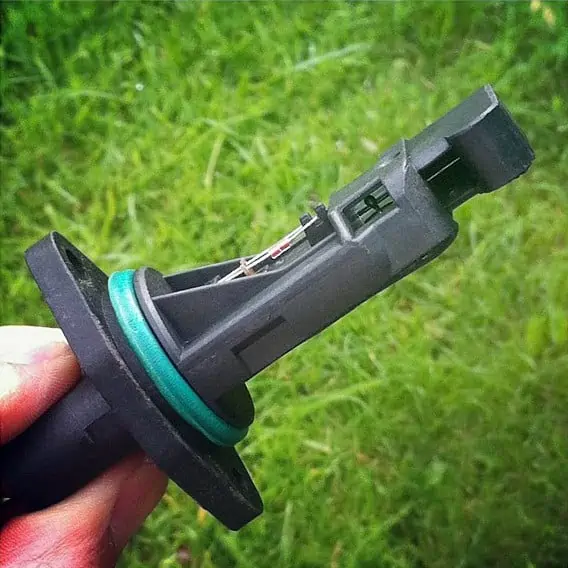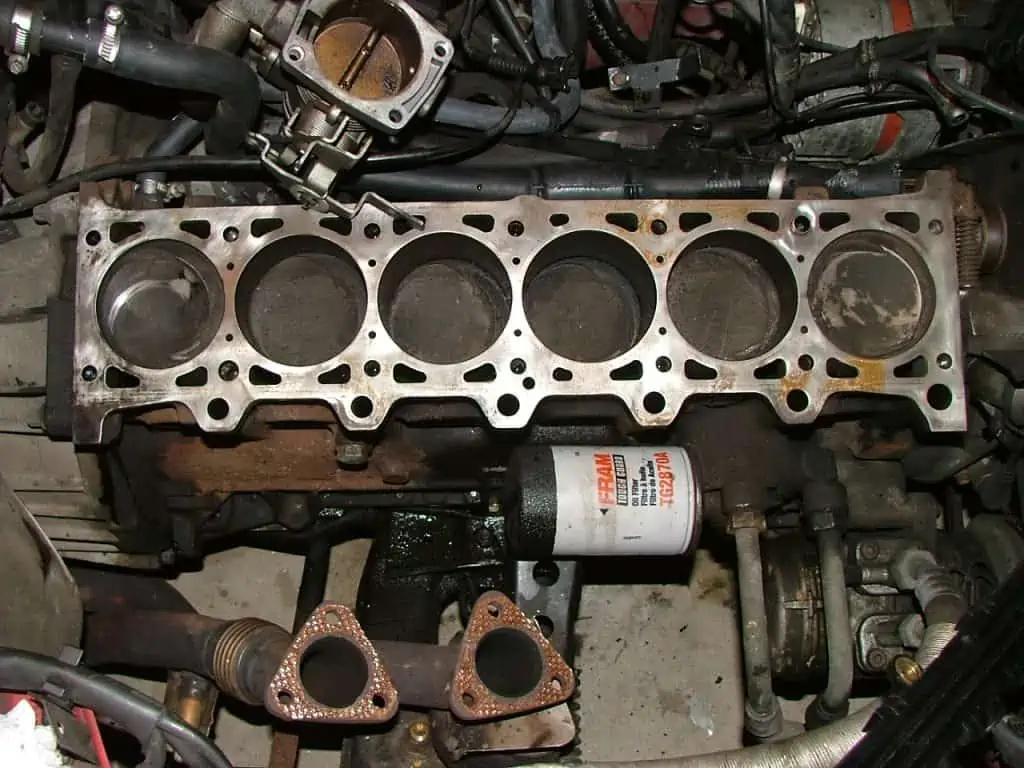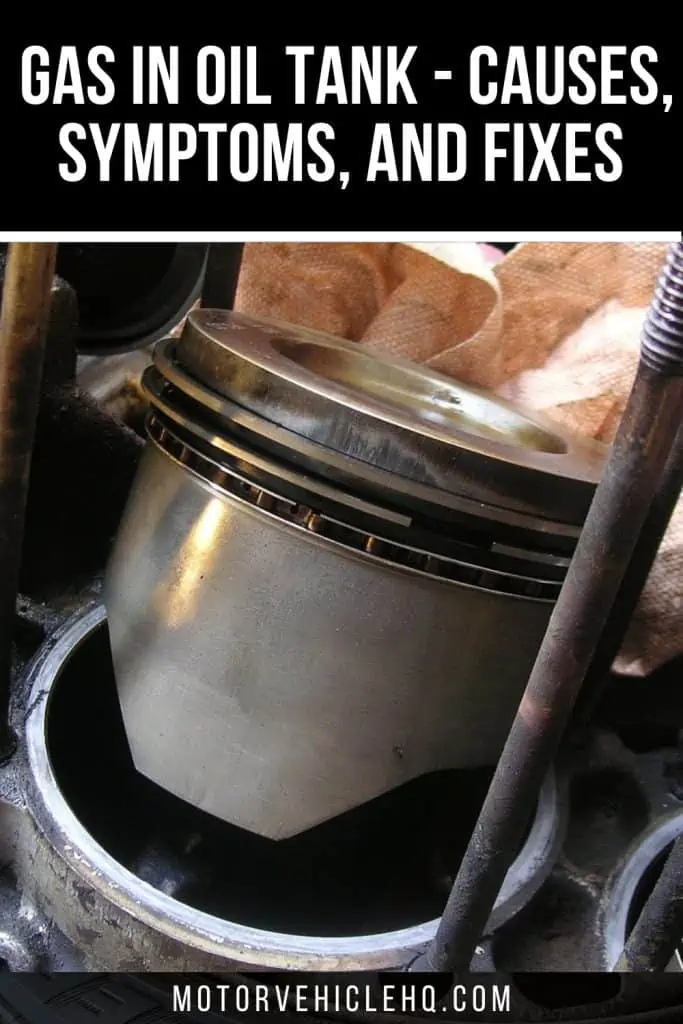Did you just change your oil, because it smelled strongly of gas? If so, you may be experiencing a gas in oil tank problem. How serious of a problem is it when gas leaks into the oil tank, you might be asking yourself? When it comes to gas engines, this is a pretty typical issue.
As soon as you notice this problem, you should resolve it. Discovering the cause of the problem will help you try to stop it from happening again in the future. Waiting too long to address this kind of issue could result in more serious problems down the road.
Your oil tank could leak gas for several reasons. Surprisingly, while the phrase gas in oil tank might make some drivers nervous, others see it as a sign that their engine is running better. Your car typically uses several fluids to keep its moving parts operating at their best.
There is transmission oil that helps keep your transmission in good shape in addition to engine oil that keeps your engine cool and lubricated. It’s not ideal for these fluids to unintentionally mix with the gas.
We’ll talk about how the gas enters the oil tank and how to tell if there’s gas in oil tank. But first, let’s gather the information you’ll need to know if you’ve ever experienced a gas in oil tank issue.
Overview of Gas In Oil Tank
If you spend enough time behind the wheel, you will inevitably run into several strange problems. Even though you might not immediately understand the source of such perplexing problems, you are likely to realize that something is wrong. Further research is necessary for these circumstances.
A situation of this kind is when you discover that the oil in your car smells like gasoline. Even though both of these fluids are necessary for engine operation, they shouldn’t mix in most situations. Therefore, it is understandable to be concerned if gasoline is discovered somewhere else in the engine than where it is supposed to be.
Spring-loaded piston rings by Interiot~commonswiki / CC BY-SA 2.0. If the piston rings are damaged, more gas will flow into the combustion chamber and the oil pan. The solution to this problem is difficult. To repair it, the entire engine must be disassembled. If the piston rings are damaged, a compression test can be used to identify the problem.
Quite seriously, this condition is known as oil dilution. Oil dilution, if severe enough, can harm lubricant viscosity and eventually result in bearing failure. Therefore, it’s crucial to identify and address the underlying cause of oil dilution as soon as possible.
Why Is Gas In Oil Tank Bad?
You’ve just realized that your engine oil contains gas. Both the vehicle and the fuel economy suffer from this problem. This is problematic because oil does not burn properly when gas and oil mix.
This indicates that it simply wastes your costly gas. Do you want the expensive gas to be wasted unnecessarily? It’s not a good idea to simply waste gas because it can be very expensive.
Another reason this is a problem is that the oil loses its ability to lubricate the engine parts when gas and oil mix. These components start to produce a lot of friction when oil can’t do its job properly, which could cause the engine to overheat.
The engine overheating is a very serious issue. This might indicate that you need to replace your expensive engine. Additionally, you run the risk of severely damaging your engine’s other parts, which could lead to their failure. If you discover that your gas and oil have combined, you should always be concerned.
Which are the Common Gas In Oil Tank Causes?
To help you understand why gas is getting into the oil, here is a lesson on the various engine components. Different cylinders and pistons are used in your engine. The piston rings on these pistons are responsible for sealing the combustion chamber.
This seal is designed to prevent outside liquids and materials from entering. Let’s assume that the piston rings are worn out or that the fuel mixture inside the cylinder chamber won’t ignite properly. The gas may then spill into the oil pan if this occurs.
You should be aware that it’s completely normal for a small amount of gas to end up in your engine oil. You shouldn’t be concerned if a little bit gets through.
This occurs naturally as you travel on your regular routes in your car. The engine is continuously supplied with gas so that it can function properly, and the oil is continuously circulated throughout the engine to ensure optimal performance.
This problem occurs when the carburetor is letting a lot of gas in or when the fuel injectors in your car become stuck open. If this occurs when the gas pedal is not depressed, it is bad.
Understanding the reasons why gas enters the oil is crucial. Here are a few of the most typical reasons.
1. A Too Rich Fuel Mixture
The fuel mixture is too rich, which is one of the main reasons why gas is leaking into the engine oil. Why does this matter? Other functional components of the engine will suffer if the fuel mixture is too rich. Because some of the fuel won’t ignite in the combustion chamber, some of it will pass through the piston rings and into the oil.
You might be asking why the mixture in my fuel is so rich. The mass airflow sensor, intake air temperature sensor, coolant temperature sensor, or O2 sensor are the typical culprits behind high fuel mixes. These all have the potential to make your fuel mixture too rich.
A high performance 4-barrel carburetor by Rich Niewiroski Jr. / CC BY 2.5. Carburetors are commonly found in older vehicles. The gas flow is managed by a diaphragm, which is operated by the gas pedal. This mechanical instruction about how much airflow to allow through is sent to the valve. Fuel will leak into the oil if this malfunctions and the valve will stick.
2. Your Piston Rings are Malfunctioning
More gas will enter the combustion chamber and flow to the oil pan if your piston rings are damaged. It is challenging to solve this issue. You need to disassemble the entire engine to fix it. Because the engine contains so many pieces, this is not a simple task. A compression test can be used to determine whether the piston rings are damaged. This will show you how effectively they are performing.
3. Occurance of Misfires
Whenever the air-fuel mixture does not ignite properly, a misfire happens. The combustion cycle is disrupted, which is terrible. Gas can wash your cylinder walls if the air-fuel mixture does not ignite.
If this occurs, compression will be reduced, allowing gas to pass more easily between the piston rings. This will eventually pour gas into your oil pan. If you see this happening, you should fix it as quickly as you can.
4. You Only Carry Out Short Drives
Do you only take your automobile for short trips? If so, you should perform engine oil changes more frequently than usual.
Fuel will be kept out of the oil pan and your oil levels will remain good as a result. Why does this result in fuel and oil mixing? Your oil pan will always contain a little amount of gas at some point.
Your gas will vaporize when your oil heats up. Short drives don’t give the oil a chance to heat up properly. As a result, you can fill the oil pan with gas for a longer time and the gas won’t vaporize.
5. Bad Carburetor
Older autos frequently have carburetors. A diaphragm, which is managed by the gas pedal, controls the flow of gas. The valve receives this mechanical instruction about how much airflow to permit through.
If this breaks down, fuel will leak into the oil and the valve will become stuck. This could result in too much gasoline mixing with the oil in the pan.
6. Fuel Injector Failure
Gasoline injectors, which are common in more recent cars, aid in supplying fuel to the combustion chamber. One or more of these injectors may spray extra fuel into a cylinder or cylinders if one of them becomes stuck in the open position.
Usually, extra gasoline in the cylinder won’t be burned during combustion. Once passed the piston rings, this unburned fuel may eventually find its way into the oil pan. Other times, even though the injectors are close together, they may still pump out too much gasoline if they are damaged.
Typically, a damaged or filthy injector won’t adequately pump in fuel. As a result, it enters the chamber as droplets rather than a mist, incompletely burning. The oil is then diluted and washed out as the unburned gasoline travels through the piston.
7. Leaking or Defective Fuel Pumps
Older carbureted cars inject fuel into the combustion chamber using mechanical pumps that are installed on engine blocks or timing chain covers and powered by a camshaft.
Fuel is supplied to the combustion chamber with the help of fuel injectors. Injectors may spray additional fuel into a cylinder or cylinders if one or more become stuck open. Combustion won’t burn the extra gasoline in the cylinder. Eventually, this unburned fuel may enter the oil pan after passing the piston rings.
These pumps pump out too much fuel when the diaphragm malfunctions and the excess fuel finally passes the piston and collects in the oil pan. Additionally, they occasionally fill the oil pan with gasoline when they internally leak fuel into the crankcase rather than the weep hole.
8. Cylinder Misfires
When the air-fuel combination in the combustion chamber fails to ignite properly, the combustion cycle is ultimately disrupted, leading to misfires. How?
When the air-fuel mixture fails to ignite, the gas typically runs off the cylinder walls, decreasing compression and allowing unburned gas to reach the piston. It finally moves from the piston into the oil pan, resulting in a mixture of gas and oil.
9. Mass Airflow Sensors Failure
The mass airflow sensors aid in calculating engine airflow. This makes it easier for the engine to determine how much gasoline is also required to get the right air-fuel ratio. The ECU may be forced to believe that your engine is running lean if the mass airflow becomes defective.
As a result, excess fuel is pumped into the combustion chamber by the injectors, which causes them to open widely and prevents the fuel from burning. The oil pan ultimately fills with gas as the extra unburned fuel eventually passes through the piston rings and into the crankcase.
10. Idling the Engine for Too Long, Specifically When It’s Cold
The petrol that sprays out of your car when you start it and let it idle for a while before moving condenses on the engine walls. When heated, it finally melts and oozes into the crankcase.
What are the Probable Gas In Oil Tank Symptoms?
How can you detect if gas is blending with oil and whether the amount is normal or not? First, there is too much gas in your oil if you can smell fuel when driving your automobile.
Another sign that there is too much gas in the oil is when your car begins to spew white smoke from the exhaust.
Low oil pressure on your oil pressure gauge typically indicates that too much fuel has spilled. Finally, you may tell that gas has gotten into the oil if your oil levels are rising without you adding extra oil.
Any of the aforementioned indications indicates that too much gas is leaking into your oil. This is not typical. To prevent future harm to your car or its engine, you must remedy this issue.
If There Is Gas In Oil Tank, How Can You Tell?
Any gas could wind up in your oil tank. A weirdo can accomplish this if they haven’t unintentionally poured it in. So don’t be shocked if it does. However, how would you know if you had gas in your oil tank if you had no idea how it got there or couldn’t recall how it got there?
1. Verify the Color of Your Oil
If you’re confused about whether you added gas or not, the color of your oil will tell you immediately whether you mixed gas and oil. The oil comes in various hues, whereas gasoline is a clear liquid. Following the oil you use, they could be blue, green, or red.
When the diaphragm fails, these fuel pumps pump out an excessive amount of fuel, which eventually passes the piston and collects in the oil pan. Additionally, they occasionally internally leak fuel into the crankcase rather than the weep hole, which causes the oil pan to occasionally fill with gasoline.
A blended oil typically has a deeper tint than regular oil. Pour some of the combined oil into a white container for improved visibility and observe (avoid colored containers). You may have had gas in oil tank mixture if the oil has an odd color that is different from the oil you are familiar with.
Does the color of your oil match that of your gas? If so, your oil contains gas. Even if you weren’t the one who introduced the gas, we will understand if you are unable to explain it. Try the following strategies in this situation.
2. Smelling
Undiluted oil has a distinct aroma that you may already be accustomed to. Fresh oil often has a mild aroma and shouldn’t overpower your sense of smell. Therefore, if you notice this stench significantly, you may have gas in oil tank.
3. Testing with a Paper Paper
Try the paper test method if you can’t tell whether your oil contains gas by looking at it. Obtain two paper grocery bags. Fill one bag with pure gas, and the other with the alleged oil-gas combination. Check after letting both bags sit for a bit.
When the gas has disappeared, the one with oil should still have oil on the bag. Assume this is the one in your car’s oil tank; the oil contains gas. This technique works well for finding gas in oil tank.
4. Test for Viscosity
Generally speaking, oil is thicker than gas, and whereas gas won’t stick to your hand, the oil will. Here’s what to do. Fill one container with a little amount of fresh oil, and another with fresh fuel. Keep an eye on how they both feel on your hand.
Put your thumb and index finger into the probable oil-gas mixture that you just poured into a container. To experience the texture of the aforementioned combined fuel, rub your fingertips together.
Now contrast how the fresh oil, fresh gas, and alleged mixed oil feel. The oil will feel less viscous in your hand if it has been added.
5. Stalling of the Engine
Another sign that you have gas in oil tank is when your engine stalls. But it all depends on how much. Small amounts of gas in the oil tank could not have a big impact on performance. After a few drives, it will burn off. However, if your engine has too much gas in oil tank, it will stall and eventually shut off.
Gas In Oil Tank: What Does That Mean?
Have you ever changed your engine oil and noticed that when the oil was dripping out, you could smell gas? Do you ever ponder the meaning or the reason behind events? Both gas and oil are crucial for your car to function correctly. They provide fuel to your car’s engine, enabling it to move.
When various engine system faults take place, gas can leak into the oil pan. You may smell gas while changing your engine’s oil if gas has seeped into your oil pan.
MAF sensor in an automotive diesel engine by Antonín Ryska / CC BY-SA 4.0. If the mass airflow breaks down, the ECU may be made to believe that the engine is running lean. The injectors open widely when too much fuel is pumped into the combustion chamber, which prevents the fuel from burning. The extra unburned fuel eventually passes through the piston rings and into the crankcase, filling the oil pan with gas.
When you change your oil, you won’t notice a strong gasoline odor, but it is typical for a little amount of gas to contaminate the oil. That isn’t typical. It can cause very serious issues if there is too much gas mixed with the oil.
Carburetor-Fitted Engines
If your carburetor is misaligned, too much gas may leak into your oil pan if you have one. Your spark plugs could be damaged if this occurs.
Checking the spark plugs is one technique to see if this is taking place. If they are dark and appear washed out, gas is likely leaking into your oil.
Another thing to be on the lookout for is if your car starts to knock. If your cylinders are not firing properly, this could be the cause. If this occurs, gas will eventually leak into your engine oil from the defective cylinder where it has been stored. It can be challenging to pinpoint the exact cause of this issue.
To do this, you will want specialized testing tools. You probably won’t be able to complete this test by yourself. You should visit a qualified mechanic so they can perform a thorough diagnosis and then provide their recommended course of action for fixing the issue.
How Is the Gas In Oil Tank Problem Fixed?
How do you correct it now that you are aware that your engine oil contains too much fuel? You are aware that having too much gas in your oil is never a good sign.
Get your car checked up by a mechanic as soon as possible. The symptoms mentioned above will all be checked for by a mechanic. They have extensive training and are well aware of what to look for.
They might propose that the piston rings are worn out if they can’t find anything more significant. These rings keep the oil from entering the cylinder by sealing it there. Additionally, this prevents fuel from dripping into the oil pan.
As you can expect, as these become worn, they will permit gas to leak into motor oil. They must be replaced if they are worn out. Examining the smoke your automobile produces is the most effective approach to determine if they need to be replaced.
Your car is burning too much gas if the smoke is thick and white. This indicates that the piston rings need to be changed.
To avoid any engine damage after replacing the piston rings, change your oil. To verify that the piston rings are functioning properly and that the issue has been resolved, you should do a compression test.
How Much Does Draining an Oil Tank Cost?
Depending on how much oil is in the tank and whether or not the tank needs to be thoroughly cleaned, draining gas from an oil tank might cost anywhere from $200 to $500. This job could cost up to $1500 if the combined oil has gotten into the engine’s oil lines and combustion chamber.
How Safe Is It to Drive with Gas In Oil Tank Issue?
Driving a car with gas that can be detected in the engine oil is generally not recommended. As gas can thin oil and lower its viscosity, doing so poses a serious threat to engine integrity. As a result, crucial component wear, such as that of an engine’s bearings, may accelerate.
A hot thick film-grid MAF sensor by The RedBurn / CC BY 2.0. Calculating engine airflow is made easier by the mass airflow sensors. Because of this, calculating the amount of gasoline needed to achieve the ideal air-fuel ratio is made simpler for the engine.
Of course, this does not imply that driving with oil that has been diluted with fuel will result in an immediate engine failure. Nevertheless, doing so carries a high risk of injury, even if it is not immediately obvious. As a result, it is preferable to refrain from using a vehicle whose oil smells like gasoline.
Several safety measures should be taken if the afflicted vehicle must be driven. The oil and oil filter of the engine should first be changed. By doing this, a sample of oil can be collected for examination. You can send this sample to a lab for analysis, which can validate any suspensions of oil dilution you may have.
In any case, the underlying source of an engine’s oil dilution problems needs to be identified and fixed as soon as possible. By doing this, you reduce the possibility of any secondary problems that could arise from driving a car without pure, undistilled oil.
Make an appointment with your preferred service shop as soon as you can if you don’t feel comfortable handling such repairs yourself.
Is Gasoline Visible In Oil?
When gasoline and engine oil mix, the gasoline is sometimes invisible. This kind of contamination is much more likely to manifest as an obvious thinned oil. Motor oil seems much more translucent as a result of this “thinning” than it would otherwise.
The oil that has been contaminated with gasoline will typically feel extremely thin to the touch. The best way to see this is to spread a little tainted oil between your thumb and index finger. This shows a relative drop in viscosity, which can quicken the deterioration of the bearings.
Do Gasoline and Oil Mix?
In general, gas and oil shouldn’t combine. Since each compartment serves a separate purpose, the oil and fuel compartments are distinct. When you see that your gas and oil have combined, something is wrong. You’ll be left wondering how and why there is gas in oil tank as a result.
Given how similar the containers are, you might have mistakenly filled an oil tank with gas. Another explanation can be that some pranksters unknowingly filled your oil tank with gas to penalize you. Alternatively, you may be utilizing a 2-cycle engine that burns a blend of gas and 2-cycle engine oil for fuel.
Will the Engine Be Affected By Gas In Oil Tank?
Gas in the oil tank will damage your engine unless you have a 2-cycled engine. You shouldn’t put gas and oil in the same compartment on a standard engine. Since your catalytic converter was not made to handle gas residue, gas in oil tank might cause stalling, the emission of blue smoke, and even coat your catalytic converter.
An engine block with six cylinders by Kether83 / CC BY 2.5. During combustion, any extra gasoline in the cylinder won’t be burned. This unburned fuel may eventually make its way into the oil pan after passing the piston rings. However, if the injectors are damaged, they may still pump out too much fuel even though they are close together.
The Conclusion
For drivers, having gas in oil tank is not unusual. It can be accidentally poured in by certain people, and it can also be done on purpose. In either case, getting the gas out of the oil system is crucial since it might damage your engine.
While dropping the tank efficiently eliminates the gas, the tainted oil can still be drained without dropping the tank.
It is up to you to decide which approach to choose. People who might have put more gas in their cars on purpose to improve performance might not bother. An excellent illustration is when drivers use gas, which includes potent detergents, in the transmission or engine oil tanks to keep their engines clean.
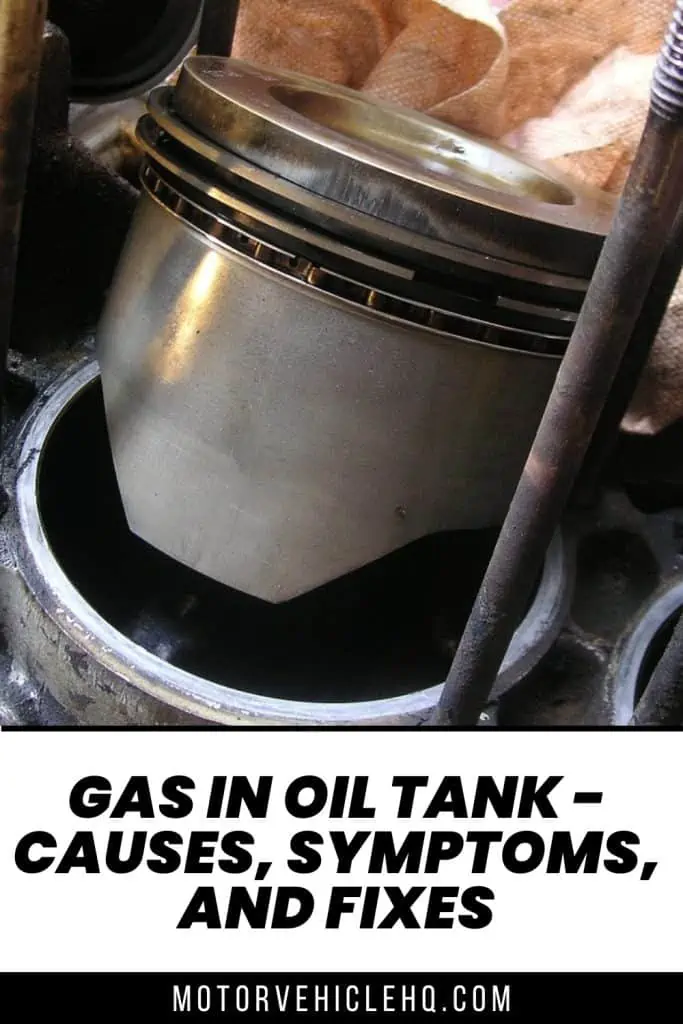
Spring-loaded piston rings by Interiot~commonswiki / CC BY-SA 2.0

Jim Wicks is the founder of MotorVehicleHQ. With over two decades of experience in the automotive industry and a degree in Automotive Technology, Jim is a certified car expert who has worked in various roles ranging from a mechanic, car dealership manager, to a racing car driver. He has owned more than 20 cars over the past 15 years. Ask him about any vehicle you see on the road and he can tell you the make, model and year. He loves the aesthetics of all things cars, and keeps his vehicles in pristine condition.
In his free time, Jim enjoys getting his hands dirty under the hood of a classic car or taking long drives along the country roads. His favorite car? A 1967 Shelby GT500, a true classic that, according to Jim, “represents the pure essence of American muscle.”
